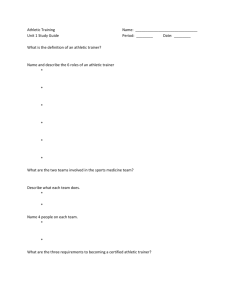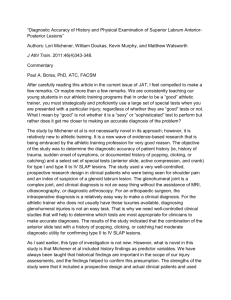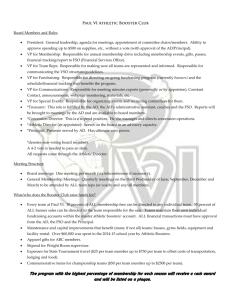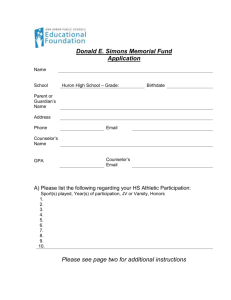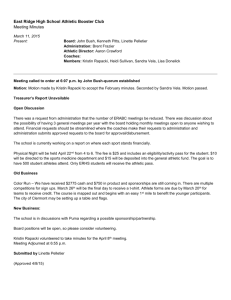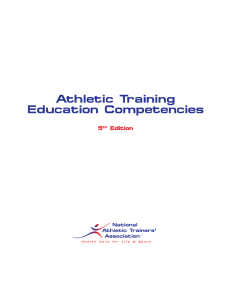Chapter 28
advertisement
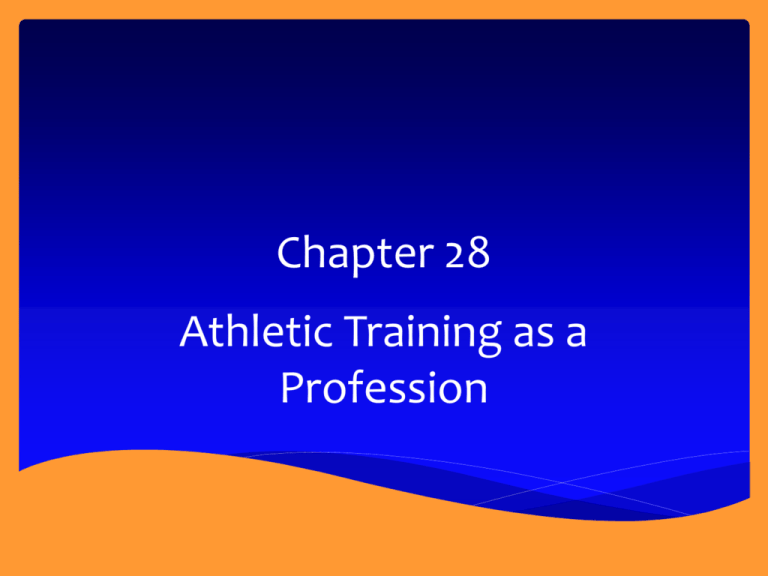
Chapter 28 Athletic Training as a Profession Objectives Define Athletic Training. Describe the roles of the ATC. Describe the roles of other health care providers and the sports medicine team. List the requirements for becoming a competent ATC. Describe the job opportunities available to ATCs. What is Athletic Training? A profession dedicated to maintaining and improving the health and well-being of the physically active population and preventing athletics-related injuries and illnesses. Athletic Trainers (ATs) are health care professionals who collaborate with physicians to provide preventative services, emergency care, clinical diagnosis, therapeutic intervention and rehabilitation of injuries and medical conditions. Athletic Training Professional Associations National Athletic Trainers’ Association Great Lakes Athletic Trainers’ Association Illinois Athletic Trainers’ Association Board of Certification Commission on Accreditation of Athletic Training Education State of Illinois Accredited Athletic Training Education Programs (ATEP) Aurora University Eastern Illinois University Illinois State University Lewis University McKendree University Millikin University North Central College North Park University Northern Illinois University Olivet Nazarene University Trinity International University Western Illinois University Roles (Domains) of an Athletic Trainer Preventative Services Clinical Diagnosis Immediate and Emergency Care Therapeutic Intervention and Rehabilitation Organizational and Professional Health and Well-being Preventative Services Injury/Illness Prevention and Wellness Protection Educating participants and managing risk for safe performance and function. Give examples of this: Pre-participation exams Emergency action plans Reviewing fields for hazards Monitor for environmental conditions Education about nutrition, performance-enhancing drugs Monitor for overtraining Maintain clinical and treatment areas Clinical Diagnosis Clinical Evaluation and Diagnosis Implementing standard evaluation techniques and formulating a clinical impression for the determination of a course of action. Give examples of this: History Observation Palpation Special Tests Then formulate a diagnosis by interpreting information gained. Educate the athlete (and parents/coaches) about the current potential injury and care. HOPS for a Foot Immediate and Emergency Care Immediate and Emergency Care Employing standard care procedures and communicating outcomes for efficient and appropriate care of the injured. Give examples of this: Coordinate care Apply appropriate care that does not exacerbate the current situation Implement appropriate referral strategies Implement and direct immediate care strategies Therapeutic Intervention and Rehabilitation Treatment and Rehabilitation Reconditioning participants for optimal performance and function. Give examples of this: Administer therapeutic and conditioning exercises appropriately Administer therapeutic modalities appropriately Apply braces, splints, and other assistive devices appropriately Administer treatment for injury, illness, or other conditions appropriately Reassess injuries and document treatments, rehabilitation and reconditioning to evaluate return to activity. Ankle Taping Video Organizational and Professional Health and Well-being Organizational and Professional Health and Well‐being Understanding and adhering to approved organizational and professional practices and guidelines to ensure individual and organizational well-being. Give examples of this: Support individual and organizational growth Support organizational sustainability, growth and development Maintain records and documentation Keep EAPs up to date Be aware of professional standards to provide safety and welfare of individual(s) and groups Develop support/referral process for interventions Sports Medicine Team Members *Sport Psychologist *Strength coach *School nurse *Dietitian/Nutritionist *Primary care physician *Urologist *Allergist Parents *Cardiologist Coach Athlete *Pediatrician *Gynecologist Team *Dentist Physician *Physical Therapist ATC *Chiropractor *Neurologist *Podiatrist *Student assistant *Equipment manager Requirements for becoming an ATC Must take coursework in the following areas: Athletic injury recognition and care Human Anatomy Human Physiology Kinesiology First aid, CPR, AED Psychology Nutrition Pharmacology Therapeutic rehabilitation Therapeutic modalities Organization and administration In addition to your general education requirements Additional Requirements You must earn a bachelor’s degree from an accredited college/university program. Starting in 2020, you will need to earn a Master’s degree from an accredited college/university program. You must pass the NATA BOC National examination. You must meet State licensure requirements to practice in (www.idfpr.com) Maintain certification through CEUs (need 50 hours ever 2 years) Job Opportunities as an ATC Traditional Settings Secondary Schools Colleges & Universities Professional Sports Hospital & Clinical Non-traditional Settings Occupational Health Military Performing Arts Physician Extender Public Safety Physician Extender Video

